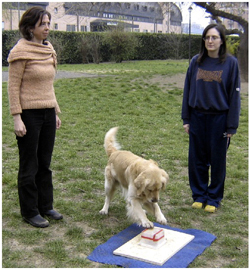Bonding With Your Dog

Agility Training Testing Scenario
One of the great benefits of agility training is an increased bond between dog and owner and the development of deeper communication skills. At the Zoom Room, we every day witness this bonding between dogs of all ages and breeds and owners with no previous dog agility experience.
But a new research study from Italy – published this year in Behavioural Processes by Sarah Marshall-Pescini et al. – sheds new light on this phenomenon and confirms our own observations.
Unstoppable Dog Meets Immovable Object
The researchers took three groups of dogs that had similar breed characteristics (controlling for genetic contributions) but divergent life experiences. In other words, one group was trained search-and-rescue dogs; a second group had extensive agility training; and the third “pet dog” group had no formal dog training experience.
All three groups were presented with a food-baited puzzle to solve. But here’s the catch: the puzzle had no solution. (They had first examined the dogs’ behavior using a fairly simple “puzzle” – delicious dog treats placed under a plastic container on a wooden board. All three groups easily flipped the container over to retrieve the goodies. In the unsolvable trials, the dastardly researchers bolted the plastic container to the board, making access to the food utterly impossible. Unless the dog knows how to operate a screwdriver or a Makita – they were in for frustration.)
Search-and-Rescue Dogs
When faced with an impossible challenge, the search-and-rescue dogs mostly focused on the task at hand. Occasionally they would look up at the humans present, dividing their gaze between their owner and the scientist. It was interesting that the dogs didn’t look for communication cues solely from their owner, since search-and-rescue dogs are trained to work out in the field with any number of strangers. So no special connection to owner was observed, and any attempts at communicating were fairly limited. The dogs also barked a good deal – displaying another aspect of their training. Mostly, they kept pawing away at the puzzle, looking for some way to succeed.
Pet Dogs
The untrained dogs made the fewest attempts either to communicate with their owners, or to look to their owners for some type of guidance or cues to help them access the impossibly-concealed food. These dogs, having never received training – and certainly without any prior experience of overcoming obstacles together with their owners – did not view their owners as sources of helpful information. They barely gazed up at either the scientist or their owners. These pet dogs simply tried to get the food, failed, and eventually gave up.
Agility Training Dogs
The performance of the dogs who had received agility training was markedly different than either of the other two groups. The dogs in this group were faced with an obstacle – a situation familiar to them since obstacles are the very essence of a dog agility course – and having trained alongside their owner throughout agility training, they enjoyed a closer bond of communication and saw their owners as a source of important information and guidance. The agility trained dogs gazed back far more than the other two groups – and solely at the owner, not the scientist – and for longer durations – and without the barks of frustration.
Agility Training Improves Communication with Your Dog
In summary, the dogs with agility training in this study behaved exactly as we would have expected: running the agility course side-by-side with your dog naturally develops and deepens the bonds of communication, and builds trust between you and your dog. It may not imbue your dog with the ability to solve unsolvable puzzles, but whenever your dog faces a new challenge, he knows that you’re his trusted ally.
- Learn more about Agility Training at the Zoom Room.
- Read our other articles about Canine Research.


Leave a comment